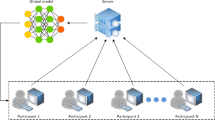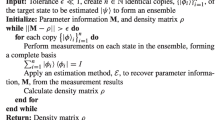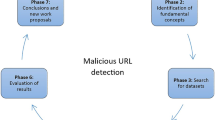Abstract
The application of machine learning to quantum information processing has recently attracted keen interest, particularly for the optimization of control parameters in quantum tasks without any pre-programmed knowledge. By adapting the machine learning technique, we present a novel protocol in which an arbitrarily initialized device at a learner’s location is taught by a provider located at a distant place. The protocol is designed such that any external learner who attempts to participate in or disrupt the learning process can be prohibited or noticed. We numerically demonstrate that our protocol works faithfully for single-qubit operation devices. A trade-off between the inaccuracy and the learning time is also analyzed.






Similar content being viewed by others
Notes
Such an assumption could be strong in a device-independent quantum cryptographic scenario [13]. However, this condition is essential in machine learning because one should trust his/her machine to identify, evaluate and control the data in the learning process.
The group generators \(\hat{G}_j\) can generally be constructed in any d. Hence such parameterization is quite general (see “Appendix 1”). The real components \(a_j\) can be matched to some real control parameters in experiments, e.g., beam-splitter and phase-shifter alignments in a linear optical system [16] or radio frequency (rf) pulse sequences in a nuclear magnetic resonance (NMR) system [17].
This starting assumption is realistic and also may be important, since a single state \(\left| \chi _A\right\rangle \) could be used as a cryptographic name (i.e., identity) of Alice in a modified protocol, as described in Sect. 5. Thus, it may be more efficient that \(\left| \chi _A\right\rangle \) is prepared as an arbitrarily superposed state, e.g., \(a \left| 0\right\rangle + b \left| 1\right\rangle \).
We assumed that there are no noise effects in the channels \({\mathcal {C}}^{AB}_r\) and \({\mathcal {C}}^{BA}_r\).
Here, \(\left| \chi _E\right\rangle \) and \(\left| \tau _E\right\rangle \) are Eve’s own fiducial and target state, respectively.
One of the powerful advantages of our protocol is that Bob does not need to set the device(s) corresponding to the target task, e.g., \(\hat{T}\), in his side, but this advantage may be weaken in the case where the security issue becomes more important.
Noting that \(\hat{W}\) has no influence on Alice’s learning in the case where \(\left| c\right\rangle \ne \left| 1\right\rangle \), it is easily checked that our previous analyses remain valid.
Note further that Eve can neither sort out \(\left| c\right\rangle =\left| 1\right\rangle \) in \({\mathcal {C}}^{\text {AB}}_r\) nor Alice’s state \(\left| \chi _A\right\rangle \) in \({\mathcal {C}}^{\text {AB}}_o\) (See also [SC.1] and [SC.2]).
The integration limits, from \(-\infty \) to \(\infty \), are approximated by this condition.
References
Langley, P.: Elements of Machine Learning. Morgan Kaufmann, San Francisco (1996)
Manzano, D., Pawłowski, M., Brukner, Č.: The speed of quantum and classical learning for performing the \(k\)th root of NOT. New J. Phys. 11, 113018 (2009)
Hentschel, A., Sanders, B.C.: Machine learning for precise quantum measurement. Phys. Rev. Lett. 104, 063603 (2010)
Bang, J., Ryu, J., Yoo, S., Pawłowski, M., Lee, J.: A strategy for quantum algorithm design assisted by machine learning. New J. Phys. 11, 113018 (2014)
Yoo, S., Bang, J., Lee, C., Lee, J.: A quantum speedup in machine learning: finding an N-bit Boolean function for a classification. New J. Phys. 16, 103014 (2014)
Tiersch, M., Ganahl, E. J., Briegel, H. J.: Adaptive quantum computation in changing environments using projective simulation. arXiv:1407.1535 (2014)
Bennett, C.H., DiVincenzo, D.P., Shor, P.W., Smolin, J.A., Terhal, B.M., Wootters, W.K.: Remote State Preparation. Phys. Rev. Lett. 87, 077902 (2001)
Reznik, B., Aharonov, Y., Groisman, B.: Remote operations and interactions for systems of arbitrary-dimensional Hilbert space: state-operator approach. Phys. Rev. A 65, 032312 (2002)
Bang, J., Lim., J., Yoo, S., Kim, M. S., Lee, J.: Quantum Learning Machine arXiv:0803.2976 (2008)
Barreno, M., Nelson, B., Sears, R., Joseph, A. D., Tygar, J. D.: Can machine learning be secure?. In: Proceedings of the 2006 ACM Symposium on Information, Computer and Communications Security, ACM, New York, ASIACCS ’06, pp. 16 (2006)
Barreno, M., Nelson, B., Joseph, A.D., Tygar, J.D.: The security of machine learning. Mach. Learn. 81, 121 (2010)
Nelson, B., Rubinstein, B.I.P., Huang, L., Joseph, A.D., Lee, S.J., Rao, S., Tygar, J.D.: Query strategies for evading convex-inducing classifiers. J. Mach. Learn. Res. 13, 1293 (2012)
Acín, A., Brunner, N., Gisin, N., Massar, S., Pironio, S., Scarani, V.: Device-independent security of quantum cryptography against collective attacks. Phys. Rev. Lett. 98, 230501 (2007)
Hioe, F.T., Eberly, J.H.: N-level coherence vector and higher conservation laws in quantum optics and qusntum mechanics. Phys. Rev. Lett. 47, 838 (1981)
Son, W., Lee, J., Kim, M.S.: D-outcom measurement for a nonlocality test. J. Phys. A 37, 11897 (2004)
Reck, M., Zeilinger, A., Bernstein, H.J., Bertani, P.: Experimental realization of any discrete unitary operator. Phys. Rev. Lett. 73, 58 (1994)
Kim, J., Lee, J., Lee, S.: Implementing unitary operators in quantum computation. Phys. Rev. A 61, 032312 (2000)
Fiurášek, J.: Linear-optics quantum Toffoli and Fredkin gates. Phys. Rev. A 73, 062313 (2006)
Wang, B., Duan, L.-M.: Implementation scheme of controlled SWAP gates for quantum fingerprinting and photonic quantum computation. Phys. Rev. A 75, 050304 (2007)
Ljunggren, D., Bourennane, M., Karlsson, A.: Authority-based user authentication in quantum key distribution. Phys. Rev. A 62, 022305 (2000)
Curty, M., Santos, D.J.: Quantum authentication of classical messages. Phys. Rev. A 64, 062309 (2001)
Curty, M., Santos, D.J., Pérez, E., García-Fernández, P.: Qubit authentication. Phys. Rev. A 66, 022301 (2002)
Bruß, D., Macchiavello, C.: Optimal state estimation for d-dimensional quantum system. Phys. Lett. A 253, 249 (1999)
Acknowledgments
We thank Professor Jinhyoung Lee for helpful discussion. J.B. thanks Chang-Woo Lee for comments. We acknowledge the financial support of the Basic Science Research Program through a National Research Foundation of Korea (NRF) grant funded by the Ministry of Science, ICT and Future Planning (No. 2010-0018295).
Author information
Authors and Affiliations
Corresponding author
Appendices
Appendix 1: Construction of SU(d) group generators
For any given d, we can generally define \(\mathbf {G}\) in Eq. (1), systematically constructing (\(d^2-1\)) Hermitian operators as follows [14, 15]:
where \(1 \le l \le d-1\) and \(1 \le j \le k \le d\). Here, \(\hat{P}_{jk} = \left| j\right\rangle \left\langle k\right| \) is a general projector. Then, the elements \(\hat{G}_j\) of \(\mathbf {G}\) can be given from the set \(\{\hat{u}_{12}, \hat{u}_{13}, \cdots , \hat{v}_{12}, \hat{v}_{13}, \cdots , \hat{w}_{1}, \cdots , \hat{w}_{d-1} \}\), satisfying (i) hermiticity \(\hat{G}_j=\hat{G}_j^\dagger \), (ii) traceless \(\mathrm {tr}(\hat{G}_j)=0\) and (iii) orthogonality \(\mathrm {tr}(\hat{G}_j^\dagger \hat{G}_k)=2\delta _{jk}\). The elements \(\hat{G}_j, \hat{G}_k \in \mathbf {G}\) hold the relation,
where \(f_{jkl}\) is the (antisymmetric) structural constant of SU(d) algebra. Here, if \(d=2\) (single qubit), we have Pauli spin operators as \(\mathbf {G} = \{ \hat{\sigma }_x, \hat{\sigma }_y, \hat{\sigma }_z \}\).
Appendix 2: Detailed data in Figs. 4 and 5
Here we provide the detailed data in Figs. 4 and 5. By performing numerical simulations while increasing \(N_L\) from 50 to 500 at intervals of 50, we characterize the learning probabilities \(P_L(n)\) and survival probabilities \(P_S(n)\). The simulations are performed 1000 times for each \(N_L\). For all the cases of \(N_L\), the survival probabilities \(P_S(n)\) are well fitted to the fitting function \(e^{-(n+1-N_L)/n_c}\) [as in Eq. (10)] with the characteristic constant \(n_c\). The parameters \(n_c\) and the (estimated) average number of iterations \(\overline{n}=N_L + n_c\) are listed in Table 1. Here, \(\overline{n}_\text {sim}\) denotes the average number of iterations actually counted in the simulations. We also find the learning error \(\epsilon _L\) (averaged over 1000 simulations) for each \(N_L\). The identified values of \(\epsilon _L\) are also given in Table 1. We note again that the fitting parameters \(n_c\) have finite values for all cases. We thus expect that learning can be completed faithfully for the given \(N_L\).
Appendix 3: Approximation of \(n_c\) in a random learning strategy
Here we approximately estimate \(n_c\) in a random learning strategy. To this end, we first consider the probability \(Pr(0|\mathbf {a})^{N_L}\) that the learning is completed for any fixed \(\mathbf {a}\). \(Pr(0|\mathbf {a})\) is the probability of the success event (namely, of measuring \(\left| 0\right\rangle \) in \(M_{0/1}\)) [see Eq. (8)]. To proceed, we introduce a continuous function,
satisfying \(\varXi (\mathbf {a}\ne \mathbf {a}_\text {opt}) < \varXi (\mathbf {a}_\text {opt}) = 1\). We note that this function \(\varXi (\mathbf {a})\) is made by minimizing \(\left| \varXi (\mathbf {a}) - P(0|\mathbf {a})\right| \) for all \(\mathbf {a}\). Thus, we infer that \(P(0|\mathbf {a})^{N_L} \rightarrow 1\) when \(\mathbf {a} \rightarrow \mathbf {a}_\text {opt}\), whereas \(P(0|\mathbf {a})^{N_L} \rightarrow 0\) when \(\mathbf {a}\) is far from \(\mathbf {a}_\text {opt}\), and consequently, we can assume that \(P(0|\mathbf {a})^{N_L} \simeq \varXi (\mathbf {a})^{N_L}\) (\(\forall \mathbf {a}\)) when \(N_L\) is very large.
We then use a trick by approximating \(\xi _j(a_j)^K\) with a delta function as
where \(a_{j,\text {opt}}\) is a component of \(\mathbf {a}_\text {opt}\) and K is assumed to be sufficiently large but \(K \ll N_L\). Thus, we can also assume that \(\varXi (\mathbf {a})^K \simeq P(0|\mathbf {a})^K\). In the circumstance, we estimate the average probability \(P(0|\mathbf {a})_\text {avg}^{N_L}\), such that (for \(\varDelta \ll 1\) Footnote 10)
Then, let us consider a probability that the learning is terminated at n iteration step:
for any sequence \(\mathbf {a}^{(0)} \rightarrow \mathbf {a}^{(1)} \rightarrow \mathbf {a}^{(2)} \rightarrow \ldots \rightarrow \mathbf {a}^{(n)}\) of updating the parameter vector in the learning. Thus, in a random learning strategy, we can approximate the learning probability \(P_L(n)\), introduced in Sect. 4, such that
where \(P(0|\mathbf {a}^{(1)})_\text {avg}^{N_L}=P(0|\mathbf {a}^{(2)})_\text {avg}^{N_L} =\ldots =P(0|\mathbf {a}^{(n)})_\text {avg}^{N_L}=P(0|\mathbf {a})_\text {avg}^{N_L}\). Here, using Eq. (15), we finally arrive at (for \(N_L \gg 1\) and \(\varDelta \ll 1\))
where \(n_c \simeq O\left( \sqrt{N_L^{(d^2-1)/2}}\right) \).
Appendix 4: Effect on learning of any alterations in \({\mathcal {C}}_o^{AB}\)
Here we consider a situation in which particles in the state \(\left| \widetilde{\tau }_A(\mathbf {a})\right\rangle \) moving through \({\mathcal {C}}_o^{AB}\) are altered with a certain probability \(p_\text {int}\) by some malicious Eve. Here, we assume a super-Eve who can sort out Alice’s estimation state \(\left| \widetilde{\tau }_A(\mathbf {a})\right\rangle \), discarding the blinded state \(\left| \widetilde{\chi }_A(\mathbf {r}_h)\right\rangle \), in \({\mathcal {C}}_o^{AB}\) for his/her own effective learning. Eve’s aim is to learn Alice’s vector \(\mathbf {a}\) and thus to obtain the optimal vector as close to \(\mathbf {a}_\text {opt}\) as possible when Alice’s learning is complete. Eve can thus adopt the strategy of learning Alice’s vector \(\mathbf {a}\) using a stolen particle for each trial and resend the newly generated particle of his/her estimated state \(\left| \widetilde{\tau }_E(\mathbf {e})\right\rangle \) to Bob, where \(\mathbf {e}\) is a vector of Eve’s own device.
However, in this case, it takes much longer to complete the learning process because some particles of \(\left| \widetilde{\tau }_A(\mathbf {a})\right\rangle \) are altered as \(\left| \widetilde{\tau }_A(\mathbf {a})\right\rangle \rightarrow \left| \widetilde{\tau }_E(\mathbf {e})\right\rangle \). To corroborate this, we perform numerical simulations of single-qubit target states (\(d=2\)). Here, we set \(N_L=100\) and consider three cases: \(p_\text {int}=0.1\), 0.2, and 0.3. We assume further that Eve can use the best strategy for each stolen particle, i.e., \(\left| \left\langle {\widetilde{\tau }_E(\mathbf {a}')}|{\widetilde{\tau }_A (\mathbf {a})}\right\rangle \right| =\frac{2}{3}\) [23]. In Fig. 7, we present the learning and survival probabilities for \(p_\text {int}=0.1\) (red), 0.2 (green), and 0.3 (blue) on a log scale. The survival probabilities are also well matched to Eq. (10). The data are listed in Table 2. Note here that \(\overline{n}\) increases exponentially with increasing alteration probability \(p_\text {int}\). In this sense, the learning efficiency is very sensitive to the alterations. Thus, by monitoring the learning time, Alice can sense even any super-Eve; if learning is too late or cannot be completed, Alice stops the learning so that Eve cannot complete the process \(\mathbf {e} \rightarrow \mathbf {a}_\text {opt}\).
(Color online) a Learning probability \(P_L(n)\) and b survival probability \(P_S(n)\) on a log scale, assuming some Eve who can steal particles moving in \({\mathcal {C}}_o^{AB}\) with a certain probability \(p_\text {int}\). We assume that Eve can adopt the best learning strategy for her learning (see the main text). Here, we set \(N_L=100\) and consider the qubit target states, i.e., \(d=2\). We consider three cases: \(p_\text {int}=0.1\) (red), 0.2 (green), and 0.3 (blue). We perform 1000 simulations to draw the graphs. In each simulation, the target state \(\left| \tau \right\rangle \) is randomly chosen. The survival probabilities \(P_S(n)\) are also well fitted to Eq. (10) (black solid lines)
Here we briefly note that, in a realistic application, Alice should evaluate and analyze the learning time, i.e., \(n_c\), by performing the learning with her own devices, before starting the protocol with Bob. Such task is carried out taking into account the errors due to the imprecise control or contaminated devices. The maximum tolerable noise in the channels should also be estimated in this stage.
Rights and permissions
About this article
Cite this article
Bang, J., Lee, SW. & Jeong, H. Protocol for secure quantum machine learning at a distant place. Quantum Inf Process 14, 3933–3947 (2015). https://doi.org/10.1007/s11128-015-1089-7
Received:
Accepted:
Published:
Issue Date:
DOI: https://doi.org/10.1007/s11128-015-1089-7





